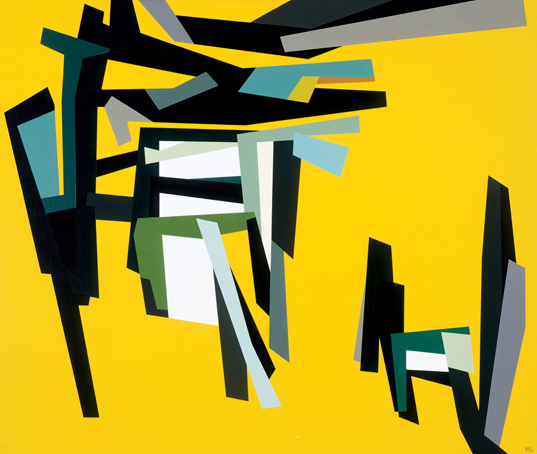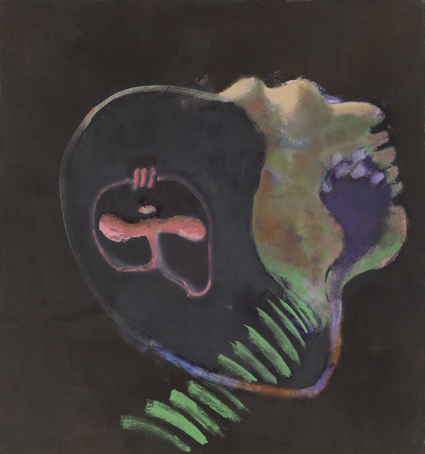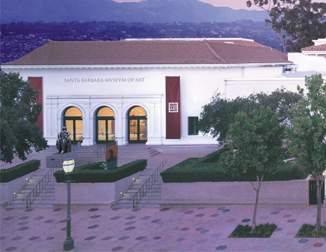
FS #1 (1961)
Karl Benjamin
Karl Benjamin’s inclusion in the exhibition Four Abstract Classicists (1959–60) defined his career as a “hard-edge” painter. This exhibition, curated by Jules Langsner and featuring the work of Lorser Feitelson, John McLaughlin and Frederick Hammersley, was viewed as Los Angeles’s answer to Abstract Expressionism. F.S. #1 is dynamic in its bold use of color as form, but highly controlled in the precision of his edge. The invisibility of his brushstrokes and the luminous finish of the oil paint, his preferred medium, produce a slick flatness and crisp fields of color that define Benjamin’s work.
Oil on panel 42 x 50 in
Santa Barbara Museum of Art, Museum Purchase.1964.6

Woman and Checkerboard (1956)
Richard Diebenkorn
Richard Diebenkorn was an active force in the Bay Area Figurative movement of the 1950s and '60s, which celebrated gestural brushwork and expressive color while championing figuration over pure abstraction. Woman and Checkerboard belongs to Diebenkorn’s early figurative works when the artist continued his expressive application of paint but began working directly from the live model. This painting was shown at the Second Pacific Coast Biennial Exhibition at the Santa Barbara Museum of Art in 1957, where it received an Award of Merit.
Oil on canvas 59 x 56 in
Santa Barbara Museum of Art, Museum Purchase, Second Pacific Coast Biennial Fund. 1957.18

Footed Bowl (1965)
Beatrice Wood
Beatrice Wood’s intimate friendship with Marcel Duchamp introduced her to the world of New York Dada in the mid-1910s, inspiring her to become an artist and leading her to coedit and contribute to the short-lived Dada magazine The Blind Man. In 1933 at the age of 40, Wood moved to Los Angeles and enrolled in a ceramics class at a local high school with the intention of making a matching teapot for set of dessert plates she had recently purchased. This rather humble encounter sparked her interest and marked the beginning of a famed career as a clay artist. Her experimentation with forms, as well as her glazing and firing techniques, was bold and unconventional. Wood eventually settled in the artistic community in Ojai, California, in 1948, where she taught ceramics for the Happy Valley School (now called the Besant Hill School) and operated her studio and showroom for fifty years.
Ceramic Diameter: 10 ¼ x 8 ¾ in
Santa Barbara Museum of Art, Gift of the artist to the Ala Story Collection. 1967.11

Untitled (Sunset Series) (1964-65)
John Altoon
John Altoon exhibited with the influential Ferus Gallery during its early years and was pitted at the center of Southern California's nascent postwar art scene. Ferus Director Irving Blum stated that “if the gallery was closest in spirit to a single person, that person was John Altoon—dearly loved, defiant, romantic, highly ambitious—and slightly mad.†Like many of his peers, Altoon began his career with an interest in Abstract Expressionism. Hedeveloped a variety of painting styles over the course of his career, including surreal, biomorphic forms and erotic, figurative drawings. Untitled (Sunset Series) comes from a mature period when Altoon returned to Los Angeles after spending several years in Europe and produced a number of iconic paintings grouped in series with titles associated with his Venice studio—Ocean Park Series (1962), Hyperion Series, Sunset Series (1964–65), and Harper Series (1966), to name a few. In late 1964, Altoon began using an airbrush to add a further layer of depth and spontaneity to the biomorphic forms that inhabited his canvases. The softened edges in this piece present a delicate merging of foreground and background.
Oil on canvas 60 x 56 ¼ in
Santa Barbara Museum of Art, Museum purchase, Ludington Deaccessioning Fund. 2010.9

Thomas W. Leavitt (1963)
Photographer Unknown
Seen here is Thomas W. Leavitt, who served as director of the Pasadena Art Museum (1957–62) and the Santa Barbara Museum of Art (1963–68).
Photograph courtesy of James Galloway












